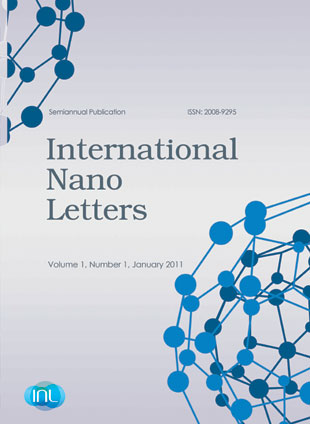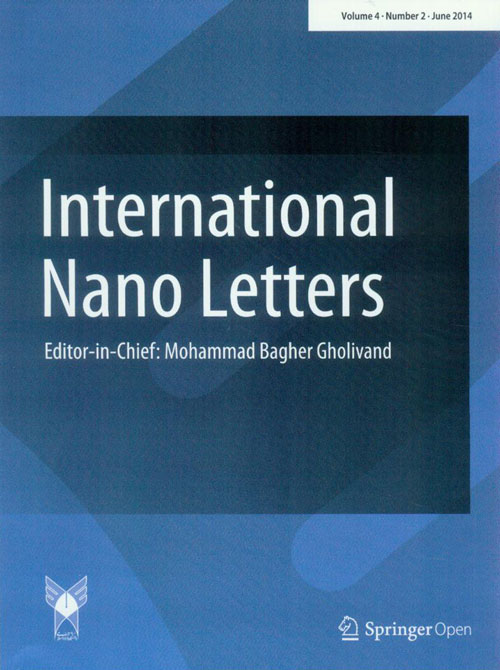فهرست مطالب

International Nano Letters
Volume:1 Issue: 1, Jan 2011
- تاریخ انتشار: 1389/09/25
- تعداد عناوین: 11
-
Pages 5-10Single wall carbon nanotubes (SWCNT) extensively are attractive from both theoretical and experimental point of view, due to its technological applications such as nano electronics devises. SWCNT are created by rolling a graphen sheet into a cyclindrical form. We have investigated the possibility of making a ferromagnetic semiconductor zigzag SWCNT by doping magnetic impurities. We found by increasing magnetic impurities doping on a zigzag SWCNT, average magnetization is increased and one can make a ferromagnetic semiconductor.
-
Pages 11-16Nanotechnology presents countless opportunities to develop new and improved consumer products for the benefit of society. Despite the wide application of nanomaterials, there is a serious lack of information concerning their impact on human health. The purpose of this study was to assess the biological assay of nanosilver (Nanocid®) on osteoblast (G292) cell line. The effect of nanosilver on these cells was evaluated by light microscopy, and by cell proliferation and standard cytotoxicity assays. The results demonstrate a concentration-dependent toxicity for the cell tested, and IC50 was determined 3.42 μg/mL, suggest that the product is more toxic to cancerous cell comparing to other heavy metal ions.
-
Pages 17-21We want to study the dynamics of a simple linear harmonic micro spring which is under the influence of the quantum Casimir force/pressure and thus behaves as a (an) nonlinear (anharmonic) Casimir oscillator. Generally, the equation of motion of this nonlinear micromechanical Casimir oscillator has no exact solvable (analytical) solution and the turning point(s) of the system has (have) no fixed position(s); however, for particular values of the stiffness of the micro spring and at appropriately well-chosen distance scales and conditions, there is (are) approximately sinusoidal solution(s) for the problem (the variable turning points are collected in a very small interval of positions). This, as a simple and elementary plan, may be useful in controlling the Casimir stiction problem in micromechanical devices.
-
Pages 22-24Silver nanoparticles (NPs) were synthesized by controlled reduction of Ag+ ions with sodium borohydride at room temperature. Nylon 6,6 was loaded with Ag nanoparticles by entrapment of Ag+ ions into the polymer network, followed by reduction. The nanocomposite was characterized by scanning microelectronic microscopy (SEM). In vitro antibacterial tests were performed using Escherichia coli (E. coli) to determine the antibacterial capability of the Ag/nylon nanocomposite.
-
Pages 25-29The properties of hydrogen adsorption in single-walled carbon nano-cones are investigated in detail by Monte Carlo simulations. A great deal of our computational results show that the hydrogen storage capacity in single-walled carbon nano-cones is slightly smaller than the capacity of single-walled carbon nanotubes at any time at the same conditions. This indicates that the hydrogen storage capacity of single-walled carbon nanocones is related to angles of carbon nano-cones. It seems that these type of nanotubes could not exceed the 2010 goal of 6 wt%, which is presented by the U.S. Department of Energy. In addition, these results are discussed in theory.
-
Pages 30-33Selective nitration of phenols with Fe (NO3)3.9H2O was carried out in the presence of nano-SiO2 at room temperature in good to high yields and short reaction times. The reactions were performed in various solvents and the catalyst could be reused for several runs. The use of nano-SiO2 as catalyst for first time is an advantage of this method.
-
Pages 34-37In the present work MCM-41 material was synthesized by a rapid method. The calcined material was characterized using XRD, scanning electron microscopy and nitrogen physisorption. The XRD pattern of calcined sample shows five well-defined peaks that indicates highly ordered MCM-41 material was synthesized. The SEM image reveals that the sample particles are in nanometer range. The isotherm of Nitrogen demonstrates a nearly reversible behavior which implies highly ordered MCM-41 material was synthesized by this method. The BET specific surface area of the sample is about 910 m3g-1. This method is also rapid and simple and results in high quality MCM-41 material.
-
Pages 38-42Maghemite (γ-Fe2O3) nanoparticles which have a wide range of applications were fabricated by microwave heating of acetylacetonato iron (III) precursor. The precursor is very easy to make, and on irradiation by microwave decomposes to maghemite nanoparticles. The as-prepared γ-Fe2O3 nanostructured has been characterized by X-ray powder diffraction, energy dispersive X-ray spectroscopy (EDX), scanning electron microscope (SEM) and transmission electron microscopy (TEM)) techniques. The maghemite nanoparticles were obtained in high yield and purity and the average size of the particles was estimated to be about 13 nm.
-
Pages 43-51This paper discusses the synthesis of nanoparticles of ZnO and MgO and ZnO/MgO nanocomposite by the sonochemical method. At first, nanoparticles were synthesized by the reaction of Zn(CHCOO3)2 and Mg(CHCOO3)2 with tetramethylammonium hydroxide (TMAH) in the presence of polyvinyl pyrrolidone (PVP) and constant frequency ultrasonic waves (sonochemical method). Then, ZnO/MgO nanocomposite was prepared through reaction of magnesium acetate with TMAH in the presence of ZnO nanoparticles and PVP as structure director using ultrasonic-assisted method. After filtration, the synthesized solution was obtained containing magnesium hydroxide in the presence of ZnO anoparticles. It was calcinated at the temperature of 550 ºC, so that ZnO/MgO nanocomposite could be produced. The effects of different parameters on particle size and morphology of final ZnO and MgO powders and ZnO/MgO nanocomposite were optimized by ‘‘one at a time’’ method. Under optimum conditions, spongy shaped, uniformed and homogeneous nanostructured zinc oxide and magnesium oxide powders were obtained with particle sizes of 25–50 and 30-60 nm, respectively. ZnO/MgO nanocomposite was also obtained with more spongy morphology and particle size about 65 nm. Both synthesized ZnO and MgO nanoparticles and ZnO/MgO nanocomposite were successfully applied to the preparation of zinc polycarboxylate dental cement.
-
Pages 52-58Nickel phosphate VSB-5 (Versailles Santa Barbara-5) was synthesized with microwave for 1 h and followed by conventional oven for 2 days in the presence of (2-hydroxyethyl) trimethylammonium hydroxide as template. By addition of ethylene glycol, nickel phosphate nanoparticle was prepared with average size of 55 nm. Also, nickel phosphate nanoparticles was synthesized by microwave assisted hydrothermal using tetrapropylammonium hydroxide as template. The spherical nickel phosphate crystals with average diameter of 80 nm were successfully synthesized in the presence of tetrapropylammonium hydroxide. Furthermore, spherical nanosized crystals were prepared with polyethylene glycol: water volume ratio of 1:1 using (2-hydroxyethyl) trimethylammonium hydroxide as template.
-
Pages 59-61In this paper, a 2D stimulation model, FACET, is used for investigation of the relation between micro structure and deposition conditions such as substrate temperature, deposition rate and deposition angle of Ag thin films. It is observed that by increasing the deposition rate in standard conditions providing that the temperature of substrate is low, the average of final grain size is decreased. While, in deposition with angle flux the average of final grain size is increased.


